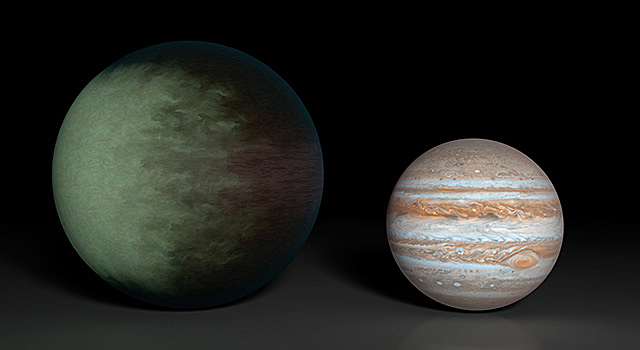TORONTO – Researchers from the Massachusetts Institute of Technology (MIT) as well as other institutions have conducted the first mapping of the distribution of clouds on an exoplanet, or a planet that orbits another star.

So how do you determine the cloud make-up on a planet that is about 1,000 light years from Earth?
Read more: Habitable planets: Is E.T. out there?
Using NASA’s Kepler Space Telescope, the team was able to generate a low-resolution map of the planet’s clouds.
As the planet, called Kepler 7b, made its orbit around its parent star, it went through various phases, just like our moon does. The visible-light observations conducted by the scientists led to a rough map of the planet that showed a bright spot on the western hemisphere.
Still, scientists weren’t convinced that this was cloud cover. So they turned to the Spitzer Space Telescope which sees in infrared light.
Spitzer provided scientists with a temperature measurement, which was between 815 C and 982 C.
- Invasive strep: ‘Don’t wait’ to seek care, N.S. woman warns on long road to recovery
- Ontario First Nation declares state of emergency amid skyrocketing benzene levels
- T. Rex an intelligent tool-user and culture-builder? Not so fast, says new U of A research
- Nearly 200 fossil fuel, chemical lobbyists to join plastic treaty talks in Ottawa
“By observing this planet with Spitzer and Kepler for more than three years, we were able to produce a very low-resolution ‘map’ of this giant, gaseous planet,” said Brice-Olivier Demory of Massachusetts Institute of Technology in Cambridge. Demory is lead author of a paper accepted for publication in The Astrophysical Journal Letters. “We wouldn’t expect to see oceans or continents on this type of world, but we detected a clear, reflective signature that we interpreted as clouds.”
The planet was too cool to be the source of light, so scientists determined that the bright spot is due to light from Kepler 7b’s star bouncing off cloud tops on the west side of the planet.
“Kepler-7b reflects much more light than most giant planets we’ve found, which we attribute to clouds in the upper atmosphere,” said Thomas Barclay, Kepler scientist at NASA’s Ames Research Center in Moffett Field, Calif. “Unlike those on Earth, the cloud patterns on this planet do not seem to change much over time — it has a remarkably stable climate.”
Before being taken out of commission in August, the Kepler Space Telescope discovered more than 150 planets.


Comments